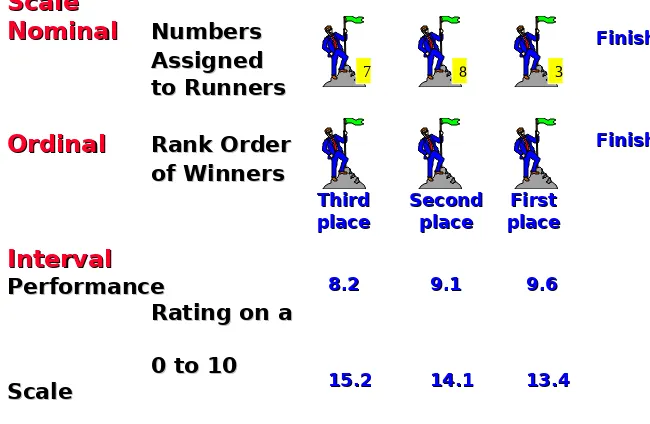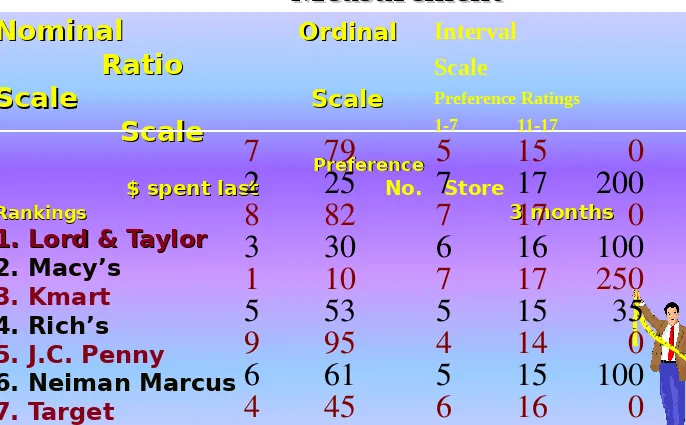Chapter VIII
Chapter VIII
Measurement and Scaling:
Measurement and Scaling:
Fundamentals and
Fundamentals and
Comparative Scaling
Chapter Outline
1) Overview
2) Measurement and Scaling
3) Primary Scales of Measurement
i. Nominal Scale
ii. Ordinal Scale
iii. Interval Scale
iv. Ratio Scale
5) Comparative Scaling Techniques
5) Comparative Scaling Techniques
i. Paired Comparison
i. Paired Comparison
ii. Rank Order Scaling
ii. Rank Order Scaling
iii. Constant Sum Scaling
iii. Constant Sum Scaling
iv. Q-Sort and Other Procedures
iv. Q-Sort and Other Procedures
6) Verbal Protocols
6) Verbal Protocols
7) International Marketing Research
7) International Marketing Research
8) Ethics in Marketing Research
9) Internet and Computer Applications
9) Internet and Computer Applications
10) Focus on Burke
10) Focus on Burke
11) Summary
11) Summary
12) Key Terms and Concepts
12) Key Terms and Concepts
13) Acronyms
Scale
Scale
Nominal
Nominal Numbers Numbers Assigned
Assigned
to Runners
to Runners
Ordinal
Ordinal Rank OrderRank Order of Winners of Winners Interval Interval Performance Performance
Rating on a
Rating on a
0 to 10
0 to 10
Scale
Scale
Ratio
Ratio Time to Time to
Finish, in Finish, in Seconds Seconds
Primary Scales of Measurement
[image:5.720.16.666.81.505.2]Primary Scales of Measurement
Figure 8.1
Figure 8.1
7 8 3
Third Third place place Second Second place place First First place place Finish Finish Finish Finish 8.2
8.2 9.19.1 9.69.6
15.2
Scale Basic Characteristics Common Examples Marketing Examples Permissible Statistics Descriptive Inferential
Nominal Numbers identify & classify objects
Social Security nos., numbering of football players Brand nos., store types Percentages, mode Chi-square, binomial test
Ordinal Nos. indicate the relative positions of objects but not the magnitude of differences
between them
Quality rankings, rankings of teams in a tournament Preference rankings, market position, social class Percentile, median Rank-order correlation, Friedman ANOVA Interval Differences between objects can be compared, zero point is
arbitrary Temperature (Fahrenheit, Celsius) Attitudes, opinions, index nos. Range, mean, standard deviation Product-moment correlation, t tests, regression
Ratio Zero point is fixed, ratios of scale values can be compared Length, weight Age, sales, income, costs Geometric mean, harmonic mean Coefficient of variation
Primary Scales of Measurement
Primary Scales of Measurement
Table 8.1
Nominal
Nominal
OrdinalOrdinalRatio
Ratio
Scale
Scale
Scale ScaleScale
Scale
PreferencePreference $ spent last
$ spent last No. Store Rankings
Rankings 3 months 3 months
1. Lord & Taylor
1. Lord & Taylor
2. Macy’s
3. Kmart
4. Rich’s
5. J.C. Penny 6. Neiman Marcus
7. Target
8. Saks Fifth Avenue
9. Sears
10.Wal-Mart
Illustration of Primary Scales of
Illustration of Primary Scales of
Measurement
[image:7.720.11.697.85.510.2]Measurement
Table 8.2
Table 8.2
7
79
5
15
0
2
25
7
17
200
8
82
7
17
0
3
30
6
16
100
1
10
7
17
250
5
53
5
15
35
9
95
4
14
0
6
61
5
15
100
4
45
6
16
0
Interval Scale
Scaling Techniques
Scaling Techniques
Non-comparative
Non-comparative
Scales
Scales
Comparative
Comparative
Scales
Scales
Paired
Paired
Comparison
Comparison
Rank
Rank
Order
Order
Constant
Constant
Sum
Sum
Q-Sort and
Q-Sort and
Other
Other
Procedures
Procedures
Continuous
Continuous
Rating Scales
Rating Scales Itemized Rating ScalesItemized Rating Scales
Likert
Likert Semantic Semantic
Differential
Differential StapelStapel
A Classification of Scaling Techniques
[image:8.720.4.713.28.484.2]A Classification of Scaling Techniques
Figure 8.2
Obtaining Shampoo Preferences Using
Obtaining Shampoo Preferences Using
Paired Comparisons
[image:9.720.12.688.54.499.2]Paired Comparisons
Figure 8.3
Figure 8.3
Instructions: We are going to present you with ten pairs of shampoo
brands. For each pair, please indicate which one of the two brands of shampoo you would prefer for personal use.Recording Form:
Jhirmack Finesse VidalSassoon ShouldersHeads & Pert
Jhirmack 0 0 1 0
Finesse 1a 0 1 0
Vidal Sassoon 1 1 1 1
Head & Shoulders 0 0 0 0
Pert 1 1 0 1
Number of Times
Preferredb 3 2 0 4 1
aA 1 in a particular box means that the brand in that column was
preferred over the brand in the corresponding row. A 0 means that the row brand was preferred over the column brand. bThe number of times
a brand was preferred is obtained by summing the 1s in each column.
Paired Comparison Scaling
Paired Comparison Scaling
RIP 8.1
RIP 8.1
The most common method of taste testing is paired comparison. The
consumer is asked to sample two different products and select the one with the most appealing taste. The test is done in private and a minimum of 1,000 responses is considered an adequate sample. A blind taste test for a soft drink, where imagery, self-perception and brand reputation are very important
factors in the consumer’s purchasing decision, may not be a good indicator of performance in the marketplace. The introduction of New Coke illustrates this point. New Coke was heavily favored in blind paired comparison taste tests, but its introduction was less than successful, because image plays a major role in the purchase of Coke.
Preference for Toothpaste Brands
Preference for Toothpaste Brands
Using Rank Order Scaling
Using Rank Order Scaling
Figure 8.4
Figure 8.4
Instructions:
Instructions:
Rank the various brands of toothpaste in order of Rank the various brands of toothpaste in order of preference. Begin by picking out the one brand that you like mostpreference. Begin by picking out the one brand that you like most
and assign it a number 1. Then find the second most preferred
and assign it a number 1. Then find the second most preferred
brand and assign it a number 2. Continue this procedure until you
brand and assign it a number 2. Continue this procedure until you
have ranked all the brands of toothpaste in order of preference. The
have ranked all the brands of toothpaste in order of preference. The
least preferred brand should be assigned a rank of 10.
least preferred brand should be assigned a rank of 10.
No two brands should receive the same rank number.
No two brands should receive the same rank number.
The criterion of preference is entirely up to you. There is no right
The criterion of preference is entirely up to you. There is no right
or wrong answer. Just try to be consistent.
BrandBrand Rank OrderRank Order 1. Crest
1. Crest __________________ 2. Colgate
2. Colgate __________________ 3. Aim
3. Aim __________________ 4. Gleem
4. Gleem _________ _________ 5. Macleans
5. Macleans __________________
6. Ultra Brite6. Ultra Brite _________ _________
7. Close Up7. Close Up _________ _________
8. Pepsodent8. Pepsodent _________ _________
9. Plus White9. Plus White _________ _________ 10. Stripe
[image:12.720.21.714.73.473.2]10. Stripe _________ _________
Figure 8.4 Contd.
Importance of Toilet Soap Attributes
Importance of Toilet Soap Attributes
Using a Constant Sum Scale
Using a Constant Sum Scale
Figure 8.5
Figure 8.5
Instructions
Instructions
Form
Average Responses of Three
Segments
Attribute Segment ISegment II Segment III
1. Mildness
2. Lather
3. Shrinkage 4. Price
5. Fragrance
6. Packaging
7. Moisturizing
8. Cleaning Power
[image:14.720.0.708.84.504.2]Sum
Figure 8.5 Contd.
Figure 8.5 Contd.
8
2
4
2
4
17
3
9
7
53
17
9
9
0
19
7
5
9
5
3
20
13
60
15





